
Quercus ilex, the evergreen oak, holly oak or holm oak is a large evergreen oak native to the Mediterranean region. It is a member of the Ilex section of the genus, with acorns that mature in a single summer.

Quercus agrifolia, the California live oak, or coast live oak, is an evergreen live oak native to the California Floristic Province. Live oaks are so-called because they keep living leaves on the tree all year, adding young leaves and shedding dead leaves simultaneously rather than dropping dead leaves en masse in the autumn like a true deciduous tree. Coast live oaks may be shrubby, depending on age and growing location, but is generally a medium-sized tree. It grows west of the Sierra Nevada mountain range from Mendocino County, California, south to northern Baja California in Mexico. It is classified in the red oak section of oaks.

Quercus douglasii, known as blue oak, is a species of oak endemic to California, common in the Coast Ranges and the foothills of the Sierra Nevada. It is California's most drought-tolerant deciduous oak, and is a dominant species in the blue oak woodland ecosystem. It is occasionally known as mountain oak and iron oak.

Quercus tomentella, the island oak, island live oak, or Channel Island oak, is an oak in the section Protobalanus. It is native to six islands: five of the Channel Islands of California and Guadalupe Island, part of Baja California.
Cedros Island is an island in the Pacific Ocean belonging to the state of Baja California, Mexico. The dry and rocky island had a population of 1,350 in 2005 and has an area of 348 square kilometres (134 sq mi) which includes the area of several small nearby islands. Cedros Island is mountainous, reaching a maximum elevation of 1,205 metres (3,953 ft). The economy is based on commercial fishing and salt production. Cedros has a distinctive flora and the traces of some of the earliest human beings in the New World. The ocean around the island is popular with sport fishermen.

Quercus lobata, commonly called the valley oak or roble, is the largest of the California oaks. It is endemic to the state, growing in interior valleys and foothills from Siskiyou to San Diego counties. Deciduous, it requires year-round groundwater, and may live up to 600 years. Its thick, ridged bark and deeply lobed leaves are characteristic, and assist in identification.
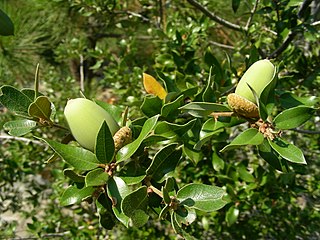
Quercus chrysolepis, commonly termed canyon live oak, canyon oak, golden cup oak or maul oak, is a North American species of evergreen oak that is found in Mexico and in the western United States, notably in the California Coast Ranges. This tree is often found near creeks and drainage swales growing in moist cool microhabitats. Its leaves are a glossy dark green on the upper surface with prominent spines; a further identification arises from the leaves of canyon live oak being geometrically flat.

Quercus dumosa is a species of plant in the family Fagaceae, belonging to the white oak section of the oak genus (Quercus). This tree goes by the common names coastal sage scrub oak and Nuttall's scrub oak.

Quercus × macdonaldii, formerly Quercus macdonaldii, with the common names MacDonald's oak and Macdonald oak, is a rare hybrid species of oak in the family Fagaceae.
Quercus vicentensis is a species of oak tree in the family Fagaceae, native to southern Mexico and northern Central America. It is placed in section Quercus.

Quercus vacciniifolia, the huckleberry oak, is a member of the Protobalanus section of genus Quercus. It has evergreen foliage, short styles, very bitter acorns that mature in 18 months, and a woolly acorn shell interior.
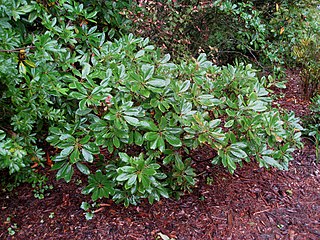
Quercus sadleriana is a species of oak known by the common names Sadler's oak and deer oak. It is native to southwestern Oregon and far northern California in the Klamath Mountains. It grows in coniferous forests. It is placed in section Ponticae.
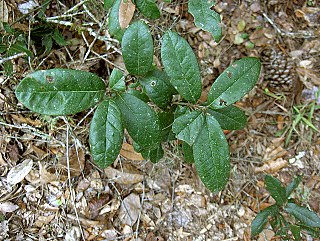
Quercus minima, the dwarf live oak or minimal oak, is a North American species of shrubs in the beech family. It is native to the southeastern United States. It is placed in the southern live oaks section of the genus Quercus.

Quercus cornelius-mulleri is a North American species of oak known by the common name Muller oak, or Muller's oak. It was described to science in 1981 when it was segregated from the Quercus dumosa complex and found to warrant species status of its own. It was named after ecologist Cornelius Herman Muller. It is native to southern California and Baja California, where it grows in chaparral, oak woodlands, and other habitat in foothills and mountains. It can most easily be observed in Joshua Tree National Park and in the woodlands along the western margins of the Colorado Desert in San Diego County, California.
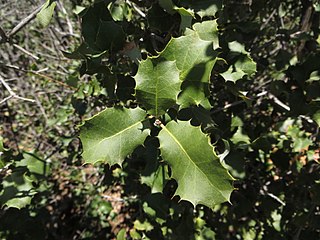
Quercus palmeri is a species of oak known by the common name Palmer oak, or Palmer's oak. It is native to California, Baja California, Southern Nevada, and in Arizona through the transition zone to the eastern Mogollon Rim, where it grows in canyons, mountain slopes, washes, and other dry habitats.

Quercus turbinella is a North American species of oak known by the common names shruboak, turbinella oak, shrub live oak, and gray oak. It is native to Arizona, California, New Mexico, Utah, Colorado, and Nevada in the western United States. It also occurs in northern Mexico.
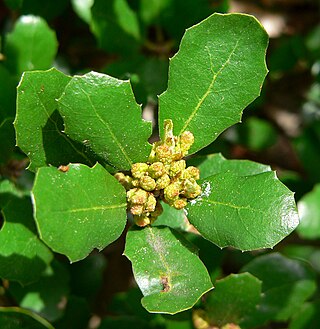
Quercus pacifica is a species of oak known by the common names island scrub oak, Channel Island scrub oak, and Pacific oak.

Quercus geminata, commonly called sand live oak, is an evergreen oak tree native to the coastal regions of the subtropical southeastern United States, along the Atlantic Coast from southern Florida northward to southeastern Virginia and along the Gulf Coast westward to southern Mississippi, on seacoast dunes and on white sands in evergreen oak scrubs.

Quercus phillyreoides is a species of flowering plant in the genus Quercus, placed in subgenus Cerris and section Ilex. It is evergreen, withstands frost and can be grown in hardiness zone 7. It is native to southern China, the Ryukyu Islands, and Japan, and has been introduced to Korea.
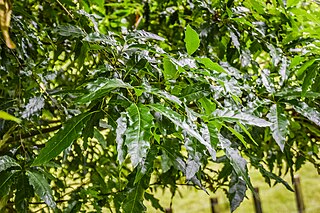
Quercus canbyi, synonyms including Quercus graciliformis, is a North American species of oak tree.




















